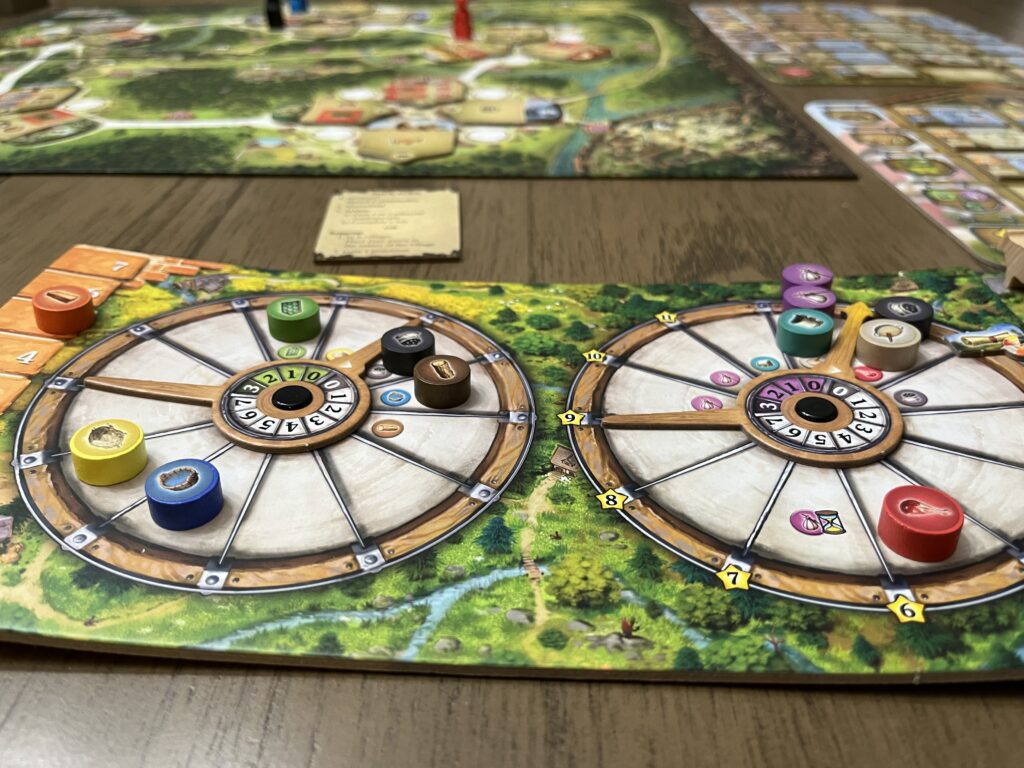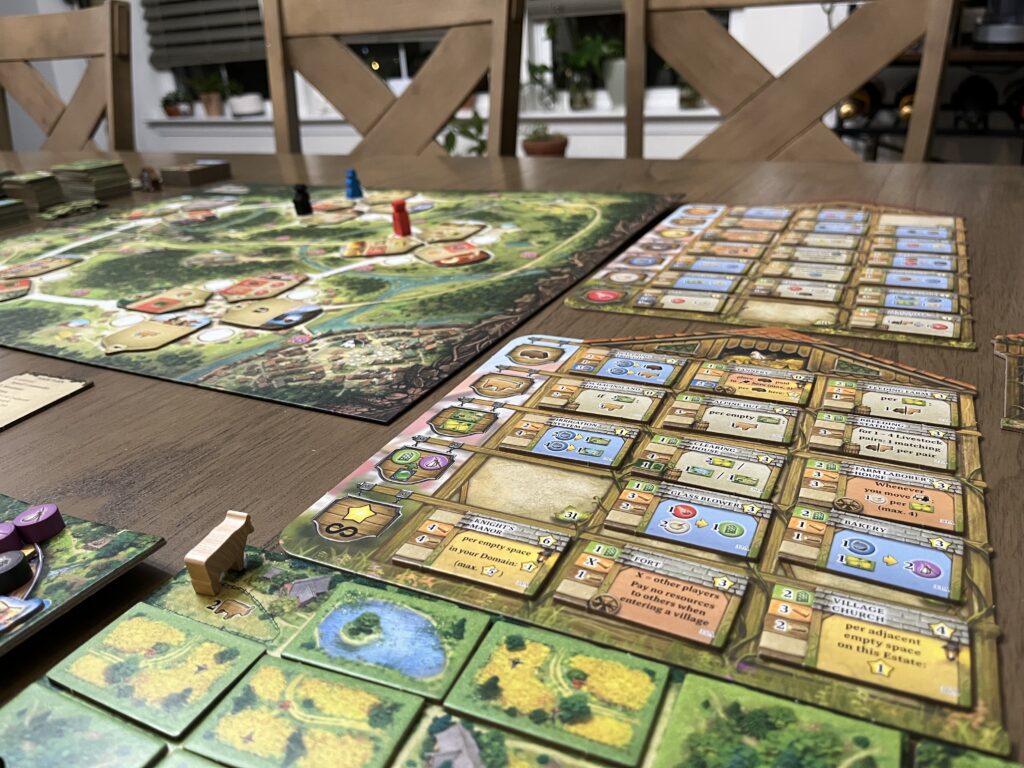Welcome to this week’s gaming post! This week I’m discussing another game I picked up at PAX which I also did an unboxing for here. So without further ado, let’s jump into my review.
Black Forest
- Designers: Tido Lorenz, Uwe Rosenberg
- Publisher: Feuerland Spiele, Capstone Games
- Complexity: Medium
- Time: 60-120 Minutes
- Players: 1-4
- Main Mechanisms: Worker Placement, Resource Wheels
Black Forest is the latest game from Uwe Rosenberg. I’ve never played Glass Road, but Black Forest feels like a combination of the resource wheels from that game, along with the building tiles from Caverna.
While the box is quite large, out of all of Uwe Rosenberg’s big box games, Black Forest feels like the most streamlined with the least amount of rules overhead. On a player’s turn, they move their singular worker around a set of villages, placing their worker on a spot between two tradespeople. Once they’ve placed their worker, the player carries out the two actions adjacent to their worker, which are usually some form of paying one type of resource to gain another. In addition, some locations also allow the player to construct buildings to add to their growing estate. I joked with my wife that I could teach the game in under five minutes, and while it will likely take you longer to explain the more intricate details of the game, once you understand how the two resource wheels operate, the rest of the game is a pretty standard worker placement affair. Also, gone are the days of needing to feed your workers, and the only real worry you have is whether you have enough provisions to travel between worker placement spots.
Speaking of, let’s talk about the resource wheels since your enjoyment of Black Forest will likely hinge on how much you enjoy this mechanism. Each player has two resource wheels that track how much of each of the different resources you have. The trick is that each of the two wheels are divided into two sections: basic and refined resources. Basic resources are tracked in clockwise increments, while refined are tracked counterclockwise. Whether you intend to or not, whenever the hands of the dial are able to rotate, they automatically do, which decreases the amount of each of your basic resources and increases the amount of your refined ones.

The meat of the game is figuring out this puzzle with the two dials. In order to rotate the dials and produce more refined resources (glass, provisions, and commodities), you have to have at least one of each of the basic resources in that same dial. You want to produce the refined resources because glass is used in the construction of many of the buildings, while provisions are used to allow you to travel between villages, ensuring your worker doesn’t get stuck in one place.
Personally, I really enjoy the resource dials, and since the dials automatically move whenever they can, it can create some frustrating but also laughable moments where you find yourself short of basic resources because you automatically produced more refined resources. However, not everyone I played the game with enjoyed the resource wheels as much as I did. My wife and brother found the wheels to be more frustrating than your typical resource management games because of this timing element. I imagine the resource wheels will be the most divisive element of the game with people either liking or disliking them, which will in turn correlate with their overall enjoyment of the game.
While initially I found the number of buildings in Caverna to be overwhelming, I found that I really enjoyed how unique the buildings were and how they opened up different strategies in that game. Black Forest also introduces plenty of buildings, as there are 36 small buildings which are doubled sided to mix up variety from game to game, as well as 14 large buildings (in each game only four or five will be available). I also love how the board for the buildings has icons for each row, which indicate which resource the buildings in that row relate to. Therefore, if I want to get more certain type of resource, all I have to do is check the buildings in that row.

Overall, I have really enjoyed the variety of the buildings, but they haven’t been able to excite me as much as the ones from Caverna. I think this largely goes back to the resource wheels. In Caverna, I enjoy the sandbox feel of being able to go all-in on a specific aspect. For example, one game I might entirely focus on raising as many sheep as possible, while another I might build a lot of ruby mines and put donkeys in them. In Caverna, it’s easier to specialize in a certain area; whereas in Black Forest, since the resource wheels only rotate when you have at least one of each of the basic resources, you’re forced to get a little bit of everything. Also, the resource wheels max out at seven for the basic resources and three for the refined resources, so gaining any more of either one is wasted.
The buildings in Black Forest also operate in a similar manner. Early on, the game recommends you build buildings that give you a permanent benefit, usually through buildings that allow you to convert one resource into another. However, it’s difficult to truly build an engine because let’s say you build the well, which allows you to spend one porridge to gain one water. Now I have to find a way to gain more porridge, so maybe I build the grain mill that allows me to remove a field to gain three porridge. However, now I have to find a way to gain more fields. You can see how this could continue to grow. While I generally enjoyed this aspect, I have found that this also leads to somewhat of a feeling where you don’t truly feel like you’re accomplishing much. At the end, you do all of these resource conversions in order to build up your estate, but by the time the game ends, you never feel like you built a proper engine.
I want to be clear that these negative sentiments didn’t heavily impact my overall enjoyment of the game. I am appreciative of Black Forest because I like the puzzle of managing the two resource wheels and the variety of buildings on offer. It also helps that the game is easy to teach and doesn’t have a long runtime, with the game ending earlier than you might anticipate. While the game doesn’t quite reach the peaks that Caverna does, I can confidently say that Black Forest is still one of my favorites from Uwe, especially among his more recent designs. I just wish that the solo mode was more than just beat your own score because I might find the game more difficult to play multiplayer after my wife and brother’s negative experiences.
With that, I’ll wrap up this week’s review! I’d love to hear your thoughts on any of the games I’ve mentioned, future content, or format in the comments section below. Happy gaming!
If you liked this post and want to be notified when new content is released, then follow me on Instagram @themeepledigest.
